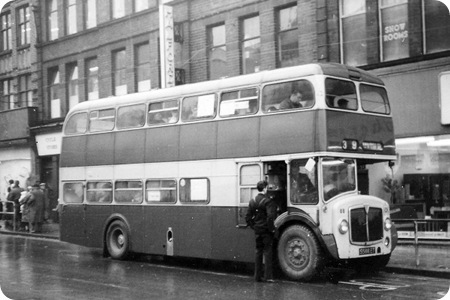
Rotherham Corporation
1964
AEC Renown 3B3RA
Roe H39/31F
There has also been a 1961 Rotherham Corporation Bridgemaster on site (link here) and the easy way to tell them apart was the front off side mudguard. It is easier to show than describe so the close up on the left is the Renown and the one on the right is the Bridgemaster.
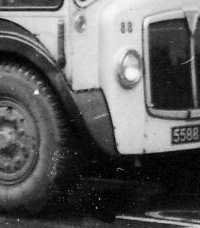
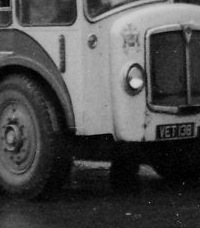
As you can see the Renown’s mudguard follows through the body where as the Bridgemaster’s body goes over the mudguard and this was always the case with these two buses.
This Renown has the AEC code of 3B3RA which meant it had an AEC 9.6 litre six cylinder engine with a 4 speed synchromesh gearbox and air brakes. There was only one alternative the 3B2RA and the only difference was it had the Monocontrol direct selection gearbox. One thing I have noticed which I find strange is that this Renown’s drivers cab door slides backwards on the outside of the body to open it normally the door slid forwards inside the cab.
A full list of Renown codes can be seen here.
———
If you look at the position of the cab door opening in relation to the front wheel it is obvious why the sliding door is external. If it was internal the wheel arch leaves nowhere for it to go, unless the door were made unreasonably shallow to pass over the top of the mudguard. For the same reason Lodekkas and other low-height buses always had hinged cab doors. The only exception seems to be the Albion Lowlander, as bodied by NCME and Alexander, where the coachbuilders raised the cab ceiling above the level of the main upper saloon floor (and raised the foremost seats to perch on top of the cab). That gave sufficient headroom to allow an internally-sliding cab door of conventional style.
David Jones
———
I’m not absolutely certain but weren’t these the only Renowns bodied by Roe? (although obviously to a Park Royal design)
Ian Wild
———
Yes, Ian. As was common in the sixties and seventies, whenever Park Royal was hard pressed, they subcontracted to their (smaller) Yorkshire partner. Geoff Lumb’s excellent book on C H Roe records in words and pictures that the Rotherham Renowns were built at Crossgates.
David Oldfield
———
11/09/12 – 06:43
I think I have a photo somewhere in my possession that show an EYMS Renown at Roes too, or am I dreaming there?
Graham
Quick links to the - Comments Page - Contact Page - Home Page
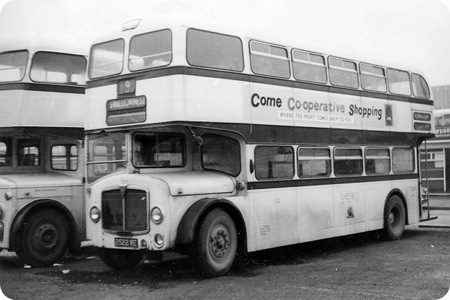
Sheffield Corporation
1959
AEC Bridgemaster
Park Royal H45/31R
Here we have a shot of one of Sheffield Corporations rear entrance AEC Bridgemaster. There was a shot of a Sheffield front entrance earlier this year (link here) and we had 2 comments disputing information, so I have done a bit of research and come up with the following.
There was six rear entrance Bridgemasters fleet no 519 – 524, 519 was delivered January 1959 and the remaining 5 were delivered in February 1959. Incidentally there was only two other production chassis built before the Sheffield six one for each Walsall no 825 and Belfast no 550, there was five other chassis but they were for AEC themselves demonstrators and test vehicles I suspect. The chassis numbers for the six were 007 – 012, it is not until April 1961 and chassis number 104 that the one and only front entrance Bridgemaster for Sheffield was built making seven in total.
So I hope that this sorts out the query into the number of Sheffield Bridgemasters, (unless you know different), my thanks to Bus lists on the Web (see credits) for most of the information.
———
“519-524 were rear entrance with a row of five rear facing seats, Lodekka style, at the front of the saloon. This covered the gearbox/differential housing – which can be seen at the front of the saloon of all traditional half-cabs. On Bridgemasters, this was extra large – hence the reason on the front entrance version for the doors to be set further back and the strange small window.”
David Oldfield
———
04/05/11 – 07:02
519 was a Commercial Motor Show exhibit in November 1958 prior to delivery. It was something of a tradition for Sheffield to have a new vehicle exhibited at what was then a bi-annual show. These were Sheffield’s first 30ft long double deckers and initially operated for a number of years on the 101 and 102 services to Gleadless and Herdings. They were later moved to the Dinnington services 6 and 19 where their low height enabled them to operate under the low railway bridge at South Anston. They had air suspension on the rear axle which I recall gave quite a bouncy motion as passengers boarded and alighted.
Ian Wild
———
05/05/11 – 06:53
…..and they hissed audibly.
David Oldfield
———
I would like to mention that the AEC Bridgemaster No.519 was a show model at Earls Court in September 1958. In early December it arrived at Queens Road and one lunchtime I rushed to the Works to catch a sight of it. My reward was to see the Rolling Stock Engineer, Ted Bale, climb into the cab, saying he was taking it to Leadmill Road. Unfortunately, I was not invited aboard. Taking a 101 route AEC Regent III to city, I alighted near to the depot, arriving there to hear Ted tell the Regulator, "Do a changeover and put it straight into service" on the 101 or 102 Gleadless route. The date was around 10th-12th December 1958.
Keith Beeden
Quick links to the - Comments Page - Contact Page - Home Page
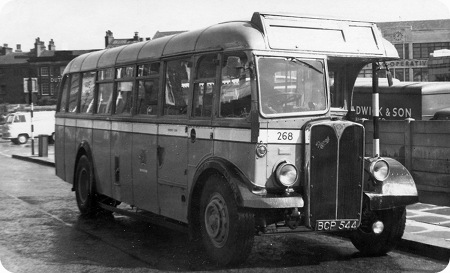
Photoraph by ‘unknown’ if you took this photo please go to the copyright page.
Halifax Corporation Transport and Joint Omnibus Committee
1949
AEC Regal III
Roe B33F
Now this is one of my favourites I have travelled miles on this bus, we had a bus club trip on this bus but unfortunately I can not remember where we went, over to Lancashire I think. This bus with its very smart Roe body was originally delivered with rear entrance in 1949 but was converted to front entrance in 1954 and became a B33F.
I can remember the way the driver had to open the doors by pulling an in cab lever about 3 foot from front to back or vice versa to close them, all mechanical no such luxury as air pressure. What is a bit strange is that the Regal had a four speed crash gearbox, I wonder why the preselect gearbox wasn’t available seeing that it was standard for the Regent RT from 1938 and optional from 1947 for the Regent III.
Strictly speaking, the preselect box was standard on all Regent/Regal IIIs, from 1947 especially with 9.6 engines. Sheffield, like Halifax, is particularly mountainous and both authorities specified non-standard AECs for a number of years. [Pre-war they continued to have 8.8 engine long after the 7.7 had become standard.]
It is generally agreed that a manual box gives more ultimate control than an epicyclic box – especially in hilly conditions. Sheffield went from preselectors to manual in 1952 for Regent III and Regal IV and stuck with manual box AECs, and Leylands, until 1961.
David Oldfield
Sorry wrong, they had pre selector gearboxes and I am sure 9.6 engines, 73 and 74 were similar Regal chassis built with double deck bodies, I am sure about the pre selector as I often climbed in the cabs of this and 269 at the back of Elmwood depot but as can be seen the door move seriously weakened the body which fell apart, the chassis would have lasted forever.
Christopher
I checked they definitely had 9.6 engines
Christopher
The pre select gearbox was designed by a Major Walter Gordon Wilson and was originally for use by British army vehicles but London Transport & Daimler made good use of it. Daimler also used it in some of their cars.
Trevor
23/11/13 – 13:48
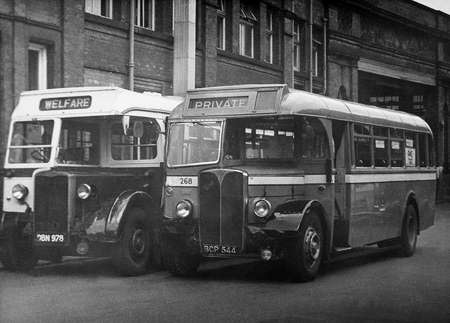
Peter mentioned in his caption (a long time back !) that he remembered 268 being used on a bus club trip to Lancashire or somewhere. It’s taken long enough to find it, but here is my own admittedly rather poor photo of it whilst on such a trip outside Bolton Corporation’s depot in about 1965 or 1966. We visited Rochdale, Bury and Bolton Corporation’s depots on that occasion, and here it is posed alongside a contemporary Crossley SD42 which was at the time being used by Bolton’s Welfare Department and I believe was the one that was later preserved.
John Stringer
26/11/13 – 07:29
Thanks John for jogging my memory I do not remember Rochdale but I was at Bolton if you go to this link I am on the right. I unfortunately did not have a camera in those days.
Peter
Quick links to the - Comments Page - Contact Page - Home Page






